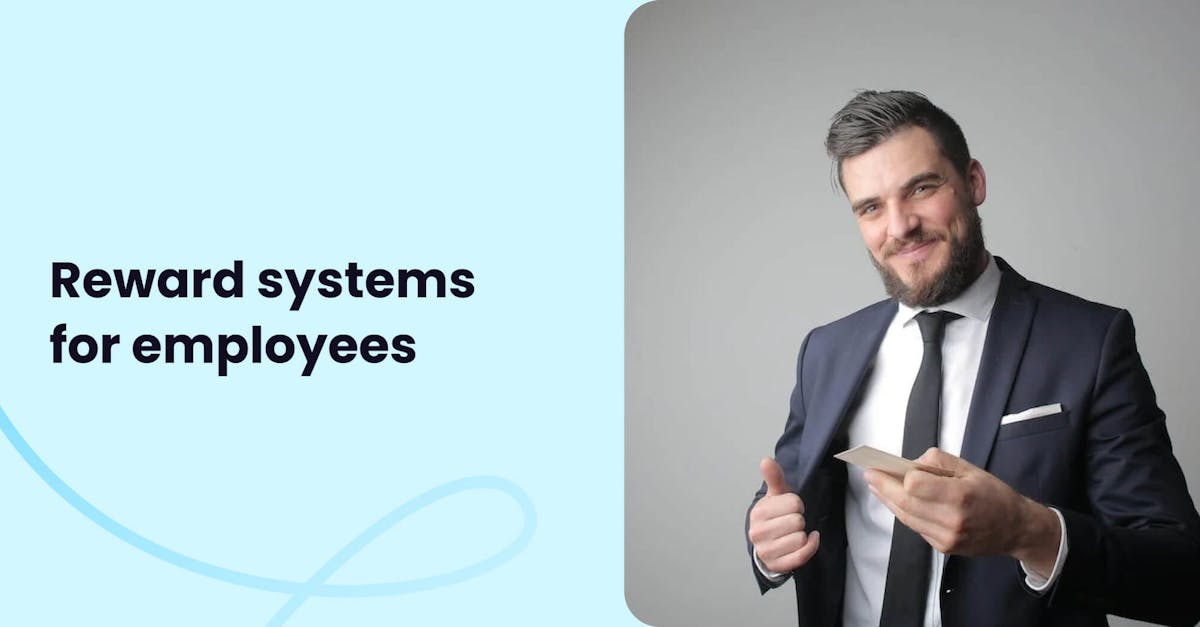All you need to know about rewards systems for employees

Employee rewards systems, also known as incentive programs or recognition programs, have become integral to modern HR strategies. These systems are designed to acknowledge and appreciate the efforts and contributions of employees within an organization.
In this article, we will explore the significance of such systems and how they can positively impact an organization.
What are reward systems for employees?
Reward systems for employees are motivational tactics that organizations use to help their staff feel encouraged to complete high-quality work. They involve giving employees rewards, such as money, gifts, praise, or recognition, for their achievements and contributions.

Reward systems for employees are important because they can:
- Increase employee satisfaction, engagement, and loyalty.
- Enhance their performance, productivity, and quality of work.
- Foster a positive organizational culture and climate.
- Attract and retain talent, and reduce turnover.
What are the different types of reward systems for employees?
What are the various types of employee rewards, and how can you choose the best one for your organization? Let's explore these options to help you make an informed decision that aligns with your employees' needs and preferences.

- Monetary rewards:
Monetary rewards encompass financial incentives such as bonuses, commissions, profit-sharing, and stock options. They boost employee satisfaction, performance, and loyalty by recognizing and rewarding their efforts with tangible financial benefits.
- Non-monetary rewards:
These are rewards that don’t involve money but rather other perks or benefits, such as flexible work arrangements, learning opportunities, wellness programs, company lunches or trips to the beaches of Normandy, gift cards, etc. This type of rewarding system is typically more cost-efficient and can even be more sought after than monetary rewards.
This desirability is directly linked to their relevance to employees. If you align rewards with individual preferences or overarching circumstances, they will be elevated. For example, teams dealing with a tight deadline for an important project will appreciate it if you provide a meal prep kit delivery service so they can eat well without being left out of pocket.
- Recognition rewards:
Recognition rewards revolve around acknowledging and appreciating employees' achievements and contributions through birthday gifts, beautiful flower arrangements, feedback, praise, awards, certificates, and badges. They elevate employee morale, boost confidence, and nurture self-esteem, affirming that the organization values and respects their contributions.
Even unique forms of recognition, such as golf tournament trophies, further enhance this affirmation, acknowledging special achievements and fostering a stronger team spirit in a non-traditional way.
- Assistance rewards:
Assistance rewards give support and guidance to employees through mentoring, coaching, training, development programs, and career advancement opportunities. These rewards are all about fostering skill development, knowledge acquisition, and professional growth, empowering employees to enhance their competencies.
- Gamified rewards:
Gamified rewards infuse elements of gaming, such as goals, points, levels, and competitions, into the reward system. They stimulate employee motivation, facilitate continuous learning, and encourage collaboration by tapping into the intrinsic rewards of mastering challenges, exercising autonomy, and serving a greater purpose.
What are the common challenges in employee rewards programs?
Some of the different common challenges in reward systems and how to avoid them are:

1. Lack of understanding
Challenge: Employees may not grasp the process, criteria, or benefits of the reward system, leading to confusion and frustration.
Solution: Communicate purpose, objectives, and outcomes transparently. Involve employees and managers in system design and implementation.
2. Lack of alignment
Challenge: The reward system may not align with organizational goals, creating a mismatch between employee needs and expectations.
Solution: Conduct a comprehensive analysis of the organization and develop a coherent reward strategy consistent with mission, vision, culture, and performance factors.
3. Lack of linkage
Challenge: Rewards may not be linked to job performance or the labor market, resulting in incorrect job evaluations and ineffective performance measures.
Solution: Establish proper job evaluation systems, well-defined job descriptions, and industry benchmark comparisons. Connect rewards to performance and behavior through SMART goals and feedback.
4. Lack of Variety
Challenge: A reward system that is too cash-focused or general may fail to motivate employees effectively.
Solution: Balance reward types, including monetary, non-monetary, recognition, assistance, and gamified rewards. Personalize rewards to cater to individual preferences and offer opportunities for employees to select or receive surprise rewards.
How can I create an effective reward system for my organization?
Creating an effective reward system for your organization can be a challenging but rewarding task. To create an effective reward system for your organization, you can follow these steps:

1. Use a survey
- Gather feedback and data from employees through surveys to understand their preferences, motivators, and satisfaction with the current reward system.
- Ask them to rank different reward types (monetary, non-monetary, recognition, assistance, and gamified) based on importance and appeal.
2. Design a purposeful system
- Align the reward system with your organizational goals, strategy, and vision.
- Define objectives, principles, criteria, components, methods, frequency, and communication.
- Determine the right mix of rewards, including base pay, variable pay, benefits, recognition, and development.
- Link rewards to performance and behavior through SMART goals, measurement, feedback, and timely recognition.
3. Inform your team
- Communicate the reward system's rationale, purpose, and benefits to your team.
- Guarantee that they understand the system, and build trust and support.
- Involve your team in the implementation and evaluation, seeking their input and feedback regularly.
4. Ask for feedback
- Monitor and assess the reward system's impact on motivation, performance, satisfaction, and engagement.
- Analyze data and gather feedback from your team.
- Identify limitations and gaps, exploring innovative approaches to rewards.
- Adapt and improve the system to meet evolving needs and expectations.
How can I use EdApp as a corporate rewards program? What are EdApp's reward features?
EdApp is a mobile learning management system that allows you to create and deliver engaging and effective microlearning courses to your employees. This makes EdApp a perfect non-monetary or employee assistance rewards program.

But apart from this, EdApp also has a built-in reward system that can motivate and incentivize your employees to complete their training, upskill them, and improve their performance. Some of EdApp's reward features are:
- Stars: Stars are virtual currency that employees can earn by answering questions correctly or logging in daily. Employees can use their stars to play games on the star bar and win real prizes.
- Real Rewards: Real rewards are tangible rewards employees can win by playing games on the star bar. Options include gift cards, vouchers, and physical items, allowing customization to fit your budget and employee preferences. Prizes are distributed automatically based on the number of prizes available and the length of the prize draw.
- Badges: Employees earn badges for completing lessons, courses, and spending stars on the star bar. These badges boost morale, confidence, and self-esteem, and are displayed on employees' profiles.
- Leaderboard: Leaderboard is a feature that shows the ranking of employees based on their stars, points, or completion rates. A leaderboard can create a sense of competition among employees, and inspire them to perform better.
To use EdApp’s reward system for employees, you can follow these steps:
- Sign up for a free account on EdApp.
- Create or choose microlearning courses that suit your training needs and goals.
- Configure the reward settings, such as the number of stars, the types of prizes, and the frequency of prize draws.
- Communicate and explain the reward system to your employees, and invite them to join EdApp.
- Monitor and evaluate the impact and effectiveness of the reward system on your employees' motivation, performance, and satisfaction.
By using EdApp as a reward system for employees, you can make learning more fun, interactive, and rewarding for your employees and enhance their skills, knowledge, and competencies.
EdApp is a mobile learning management system designed for today’s digital habits, delivering more engaging and effective micro-learning directly to learners anytime and anywhere.
Sign up for this training rewards tool today.
Author
Stephanie Escuadro
Stephanie is an eLearning content writer for EdApp, a microlearning solution designed for today's digital habits. She creates content about cutting-edge learning technologies and resources to help companies deliver great training experiences. When not absorbed in writing, she spends her time taking care of her dog and binge-watching.
